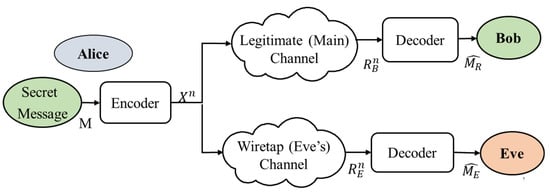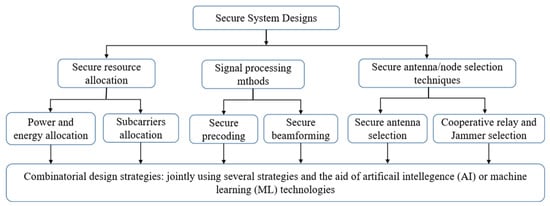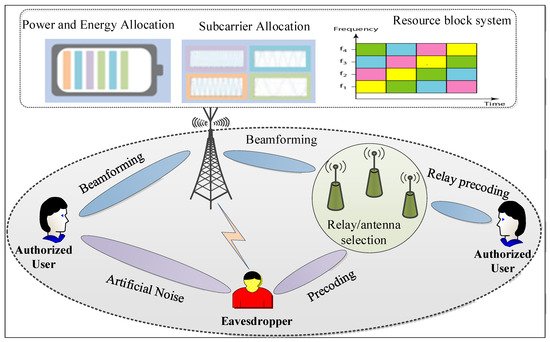With the proliferation of 5G mobile networks within next-generation wireless communication, the design and optimization of 5G networks are progressing in the direction of improving the physical layer security (PLS) paradigm. This phenomenon is due to the fact that traditional methods for the network optimization of PLS fail to adapt new features, technologies, and resource management to diversified demand applications. To improve these methods, future 5G and beyond 5G (B5G) networks will need to rely on new enabling technologies. Therefore, approaches for PLS design and optimization that are based on artificial intelligence (AI) and machine learning (ML) have been corroborated to outperform traditional security technologies. This will allow future 5G networks to be more intelligent and robust in order to significantly improve the performance of system design over traditional security methods.
- physical layer security
- optimization approaches
- information theory
- signal processing techniques
- resource allocation
- AI techniques
1. Introduction
| Existing Papers | Research Issues | Important Content |
|---|---|---|
| [12] | Examine the security threats and corresponding defense methods in PHY security. | Summary of the security requirements and threats in wireless networks considering the network protocols at various levels of data layers. Additionally, a comprehensive review of state-of-the-art PHY security and existing security protocols for 13 various wireless networks. |
| [25] | A comprehensive survey on the basic theories and key technologies of PHY security. | Discussion of the key technologies, limitations, and solutions of PHY security from the perspective of security coding, physical-layer authentication, secret key generation, and multi-antenna techniques. |
| [26] | Security threats and the corresponding countermeasure techniques. | Technologies, security attacks, and defense mechanisms in PHY security using game-theoretic approaches. |
| [27] | Overview of the key technologies of PHY security. | Recent technologies, optimization techniques, and limitations of PHY security from the perspective of information-theoretic security and wiretap channels. |
| [28] | A comprehensive investigation of multi-antenna techniques. | Survey of multi-antenna techniques in multi-user networks for improving the security performance of PHY security, but not considering CSI accuracy. |
| [29] | A brief survey on multi-antenna techniques. | Investigation on multi-antenna techniques in PHY security for improving secrecy performance considering the accuracy of CSI. |
| [30] | A comprehensive overview of the optimization and design strategies of PHY security. | Survey on security designs and optimization techniques from the viewpoints of information theory and security metrics in wireless PHY security. |
| [31] | Comprehensive overview of all existing PHY security techniques. | Classification of the existing PHY security techniques and brief discussion of the big picture they can be easily understood and applied in different communication systems. |
| [32] | Challenges of PHY security in real-world systems. | Identification of the existing assumptions and opportunities for applying PHY security in practical applications. |
| [34] | A comprehensive investigation of AI and edge computing (EC) for PLS. |
Identification of the existing challenges in the design and optimization of PLS and design of an enhancement scheme for PLS application. |
2. Fundamental Concepts
2.1. Generic System Model

2.2. Wireless Adversary Models
2.2. Wireless Adversary Models
Due to the inherent characteristics of wireless communication, such as broadcast nature, openness and the superposition of the transmission medium, wireless networks are extremely vulnerable to security attacks. Within the field of security, an adversary refers to a wireless attacker who aims to disrupt or prevent transmitted signals from reaching the intended receiver. Therefore, it is important to consider adversaries when designing a secure strategy in order to measure the effectiveness of the proposed security system. Security attacks on wireless networks can be mainly classified into two types: active attacks and passive attacks [38]. The concept of passive or active attacks is typically to do with whether the adversary is actively injecting into the communication system or is merely listening to the ongoing transmissions [39]. Due to the various types of adversaries and the vast nature of attacks, there is a need to identify the assumptions, goals and capabilities on which these different types of PLS are designed and the potential challenges that could prevent PLS from succeeding. A relevant set of goals is important for the modeling of a rigorous and strong adversary model. Naturally, a stronger adversary, i.e., with prior knowledge or more resources, could be able to attack the wireless network more successfully. With the adversary model, the assumptions of the adversary include its environment and resources, such as competency, knowledge, equipment, devices, etc. The adversary aims to compromise and obtain secret data content from within the communication system. These sets of data can be the legitimate transmission data or the property of the authorized user, e.g., energy consumption [40][41][40,41]. Due to their exposure to various types of attacks, communication channels are required to have determined capacities that enable them to resist and alleviate wireless attacks. These capabilities provide the adversary with reliable interactions that are based on the context of secure transmission systems. In fact, many of the PLS approaches assume that Alice has no knowledge of the eavesdropper’s CSI as the adversary is passive (i.e., not actively modifying the data, just silently reading and observing the communication system). On the other hand, some studies have found that Alice is sometimes assumed to know about the CSI of the eavesdropper [42][43][44][42,43,44]. Furthermore, active attacks have sometimes been observed, such as the denial of service, replay and node malfunction attacks that are employed against PHY security approaches. As a security community, reswearchers need to adopt a strong adversary model in which the adversary is cleverer and more active. Under the implications of an adversary being an active attack, intruders use more intrusive and aggressive methods that aim to deteriorate the received signal quality for the intended user. The essential characteristics of a secure transmission system include authentication, availability, integrity, access control, and secret dissemination [38]. These can be established through appropriately designed signal processing strategies and channel coding techniques. The adversary model that is used in most PLS approaches is different from that used by the traditional cryptography and security community. Therefore, for the purpose of addressing the challenges that face PLS, it is important to bridge the gaps between the various adversary models that are used by the different communities. In the current rentryview paper, the PLS mainly focuses on the premise that the eavesdropper is passive, i.e., it does not communicate with the other nodes in order to conceal its presence.3. Research Directions for System Designs and Optimization Concepts
Mainstream studies on PLS system design can be generally summarized by two main approaches. The first is related to secrecy features, which particularly focuses on the characterization of security capacity and eavesdropping or the more general trade-off between attainable secrecy capacity and confidentiality equivocation based on the concepts of information-theoretic fundamentals. The second approach is related to secure system design, which mainly focuses on the design and optimization of secure transmission strategies through the use of signal processing techniques [37][45][46][47][37,69,94,95]. Many conventional technologies in physical layer security, without the consideration of secrecy communication, can be reconstructed for secure data transmission under the fundamental framework of PLS. To realize the basic optimization problems and performance metrics of PLS, the main issues and research directions are expected to include three candidates for secure design strategies, as illustrated in Figure 28. These research topics are signal processing techniques, secure resource allocation and secure antenna selection/cooperative nodes. Improvements in secret communication within PLS can be supported by these research topics [30]. The signal processing techniques utilize secure precoding and beamforming to achieve the design of efficient secure communication strategies. The secure precoding and beamforming designs fully utilize the characteristics of multi-node and multi-antenna scenarios, which may form virtual or massive MIMO networks. Resource allocation, which is usually adopted within conventional communication systems, includes the allocation of power and subcarriers. It mainly focuses on resource management systems that utilize multi-faceted wireless resources, including power, time slots and frequency. Cooperative nodes or secure antenna selection, such as jammer selection, relay node selection and user selection, which are widely used in multiple node scenarios, have been fully explored as promising methods to improve the design of PLS. Such techniques attempt to select appropriate cooperative nodes or antennae from a candidate set to enhance the efficiency of secure design strategies.
3.1. Main Technical Challenges in System Design
Keyless-based PLS techniques are well established transmission strategies that can enhance the performance variation between the main transmission channel and wiretap channels. Unlike conventional transmission methods, the optimization objectives, the conditions of constrained optimization problems and the performance parameters that are associated with SINR-based security techniques are based on the characteristics of wireless channels and information theory secrecy metrics. For secure physical layer design and optimization schemes, the selection of suitable performance metrics is crucial. As illustrated in Figure 39, multi-dimensional security and resource management strategies typically contain secure resource allocation and signal processing methods for cooperative wireless networks. Resource allocation systems are employed by the network operator, which are shown in the top position; simultaneously, the signal processing schemes are operated by transmitters, which are positioned on the bottom. Multiple-antenna techniques have been widely used in wireless networks due to their spatial degrees of freedom, which are offered by multi-service networks. Although secure multi-antenna techniques are widely implemented in various design approaches, they can also be mathematically modeled as optimization problems to find the most favorable transmission solutions. This can be realized and optimized by using information-theoretic security metrics to design secure beamforming and precoding, appropriate antenna or relay node selection and resource allocation. Most of the problems in PLS are caused by non-convex optimization due to the characteristics of quadratic programming functions in the performance metrics. Many researchers have carried out extensive work on formulating and solving these optimization issues in order to obtain the maximum level of security [48][96]. By considering the complexity of these non-convex constraint functions, several signal processing techniques and optimization methods have been developed to solve the corresponding optimization problems.
